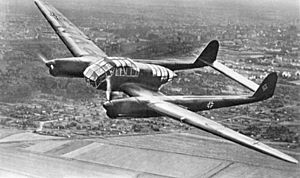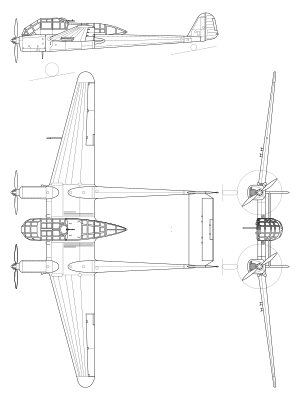Focke-Wulf Fw 189 Uhu facts for kids
class="infobox " style="float: right; clear: right; width: 315px; border-spacing: 2px; text-align: left; font-size: 90%;" ! colspan="2" style="text-align: center; font-size: large; padding-bottom: 0.3em;" | Fw 189 Uhu |-
|- | colspan="2" style="text-align: center;" | 
|-
! Role | Tactical reconnaissance and army cooperation aircraft, light bomber |-
! Manufacturer | Focke-Wulf |-
! Designer | Kurt Tank |-
! First flight | July 1938 |-
! Introduction | August 1941 |- ! Retired | 1945 |-
! Primary users
- Hungarian Air Force
- Slovak Air Force
|- ! Produced | 1940–1944 |- ! Number built | 864 |-
|}
The Focke-Wulf Fw 189 Uhu ("Eagle Owl") was a special German airplane from World War II. It had two engines and a unique "twin-boom" design, meaning it had two tails connected by a central cabin. This plane was mainly used for reconnaissance, which means flying over enemy areas to gather information. It also helped the army on the ground.
The Fw 189 first flew in 1938 and started being used in 1940. It was built until mid-1944. Even though it looked a bit fragile, it was very good at its job, especially on the Eastern Front.
Contents
What Made the Fw 189 Special?
How the "Flying Eye" Was Designed
In 1937, the German Air Ministry wanted a new plane to help their army. They needed a three-seat plane that could see everything around it, replacing an older model. Two companies, Arado and Focke-Wulf, were asked to design this new aircraft.
Arado suggested a more traditional plane with one engine. But Kurt Tank, the main designer at Focke-Wulf, came up with something different: the Fw 189. It had two small engines and a central cabin for the crew. This cabin had lots of glass, giving the crew an amazing view.
Unique Features and Production
The Fw 189 had a clever defense system. It had a special rotating gun position at the back, designed by Ikaria-Werke. This allowed a machine gun (or two) to shoot at enemies behind the plane.
Many Fw 189 planes were built. They were made in factories in Bremen (Germany), Bordeaux-Merignac (France), and Prague (Czechoslovakia). In total, 864 of these aircraft were produced.
How the Fw 189 Was Used in War
The "Flying Eye" on the Eastern Front
Soldiers called the Fw 189 the "Flying Eye" of the German Army. It was used a lot on the Eastern Front during World War II, which was the fighting between Germany and the Soviet Union. Soviet soldiers nicknamed it "Rama," which means "frame," because of its distinctive shape.
Even though it wasn't very fast and looked delicate, the Fw 189 was surprisingly hard to shoot down. It was very agile and could turn in tight circles. This made it difficult for enemy fighter planes to follow and attack it.
Night Missions and Fighter Versions
Towards the end of the war, some Fw 189s were used for special night missions. They would fly at night to scout or drop small bombs. These planes often didn't have the usual rear machine gun.
A few Fw 189s were even turned into night fighters. Their reconnaissance gear was removed, and they were fitted with radar in the nose. They also had a special cannon that fired upwards and forwards, called Schräge Musik. This allowed them to attack enemy bombers from below. However, because fuel was scarce and enemy planes were strong, these night fighters didn't shoot down many aircraft.
Different Types of Fw 189 Planes
The main version of the Fw 189 was the Fw 189A, used for reconnaissance. Most of these had two Argus As 410 engines.
- Fw 189 A-0: These were ten early planes used for testing.
- Fw 189 A-1: This was the first main production version. It had machine guns in the wings and at the back, and could carry four 50 kg (110 lb) bombs. It also carried cameras for taking pictures.
- Fw 189 A-1 trop: This was a version of the A-1 made for tropical areas, with special air filters.
- Fw 189 A-2: This version had stronger machine guns at the back.
- Fw 189 A-3: This was a tropical version of the A-2.
- Fw 189 A-4: This was a planned version for attacking ground targets. It would have had bigger cannons in the wings and extra armor to protect the plane.
There was also the Fw 189B, which was a five-seat training plane. Only 13 of these were built. The Fw 189C was designed to be a heavily armored ground-attack plane, but it wasn't very good and was never produced.
Other experimental versions included:
- Fw 189D: A proposed trainer floatplane (a plane that lands on water).
- Fw 189E: A prototype with different engines.
- Fw 189 F-1: An A-1 plane with new, more powerful Argus As 411 engines.
- Fw 189 F-2: This version had electric landing gear, more fuel, and extra armor, also with the Argus As 411 engines.
Who Used the Fw 189?
 Germany Luftwaffe (German Air Force)
Germany Luftwaffe (German Air Force) Bulgaria Bulgarian Air Force
Bulgaria Bulgarian Air Force Hungary Royal Hungarian Air Force
Hungary Royal Hungarian Air Force Norway Royal Norwegian Air Force (after the war)
Norway Royal Norwegian Air Force (after the war) Romania Royal Romanian Air Force
Romania Royal Romanian Air Force Slovakia Slovenské vzdušné zbrane (Slovak Air Force)
Slovakia Slovenské vzdušné zbrane (Slovak Air Force)- Slovak Insurgent Air Force
The Last Surviving Fw 189
There is only one Fw 189 left in the world! It's called V7+1H (Werk Nr. 2100). This plane was part of a reconnaissance group and flew its first mission on May 4, 1943. During that mission, it was attacked by Soviet Hawker Hurricane fighters.
The plane was badly damaged and crashed into treetops. The pilot, Lothar Mothes, survived, but two other crew members died. Mothes spent two weeks in freezing temperatures, avoiding Soviet patrols, before making it back to his base. He recovered and went on to fly many more missions.
In 1991, the wreckage of V7+1H was found in the Russian forest, 48 years after it crashed. A group of British plane fans bought it and brought it to the United Kingdom. They formed a group to restore the plane so it could fly again. In 1996, Lothar Mothes, the original pilot, even got to see his old plane again at an airshow!
It was later reported that this aircraft was bought by Paul Allen’s Flying Heritage Collection and was being rebuilt to fly. However, as of August 2021, it was listed for sale.
Facts and Figures (Fw 189 A-1)
- Crew: 3 people
- Length: 11.9 meters (about 39 feet)
- Wingspan: 18.4 meters (about 60 feet)
- Height: 3.1 meters (about 10 feet)
- Wing area: 38 square meters (about 409 square feet)
- Empty weight: 2,690 kg (5,930 lb)
- Maximum takeoff weight: 3,950 kg (8,710 lb)
- Engines: 2 × Argus As 410A-1 V-12 air-cooled piston engines, each providing 465 PS (459 hp, 342 kW)
- Propellers: 2-bladed Argus variable-pitch propellers
- Maximum speed: 344 km/h (214 mph) at 2,500 meters (8,200 feet)
- Cruise speed: 317 km/h (197 mph)
- Landing speed: 120 km/h (75 mph)
- Range: 940 km (580 miles)
- Service ceiling: 7,000 meters (23,000 feet)
- Climb rate: 5 meters per second (980 feet per minute)
- Time to altitude: 4,000 meters (13,000 feet) in 8 minutes 18 seconds
Armament (Weapons)
- Guns:
- 2 × 7.92 mm (.312 in) MG 17 machine guns in the wing roots, firing forward.
- 1 × 7.92 mm (.312 in) MG 15 machine gun in a flexible mount at the top rear.
- 1 × 7.92 mm (.312 in) MG 15 in the rear cone (optional).
- Bombs:
- 4 × 50 kg (110 lb) bombs.
See also
 In Spanish: Focke-Wulf Fw 189 para niños
In Spanish: Focke-Wulf Fw 189 para niños
- Twin-boom aircraft
- Similar aircraft
- Blohm & Voss BV 141
- Fokker G.1
- Sukhoi Su-12
- Lists related to this aircraft
- List of military aircraft of Germany
- List of World War II military aircraft of Germany
Images for kids



